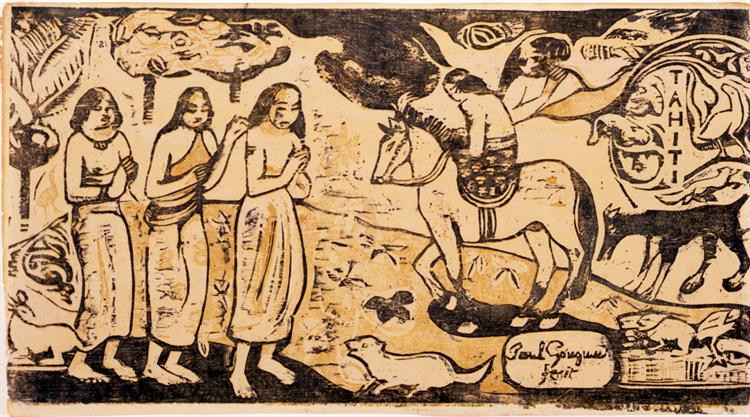Popis
Paul Gauguin's Change of Residence (1899) is a fascinating example of the turn towards the primitive and the exotic that characterized much of his production, especially during his stay in Tahiti. In this painting, Gauguin presents a composition that reveals both his interest in narrative and his exploration through a post-impressionist style that challenges the conventions of color and form.
In the foreground of the painting, two human figures appear to be in motion, moving their lives from one setting to another. The figures are dressed in a simple, emblematic manner, reflecting the local aesthetic that Gauguin adopted and reinterpreted. These figures, while not easily identifiable in their individuality, evoke a sense of shared humanity and a transition that could symbolize both physical and spiritual change.
The colour palette Gauguin employs is vibrant and bold. The saturated shades of green and blue that dominate the landscape evoke a tropical environment that is both fascinating and alienating. This use of colour not only provides a sense of place, but also acts as a vehicle for emotion. The choice of complementary and contrasting colours allows the painting to vibrate with energy, suggesting a world full of life and vitality. In addition, the shadows provide a dimensionality that reinforces the sense of movement and change inherent in the scene.
The composition has an almost asymmetrical balance, with the human figures at the bottom left, and a background that unfolds to the right with rich, lush vegetation. This imbalance, which may seem chaotic, actually reflects an organic quality, inviting viewers to experience a visual journey that resembles the very experience of change and transition.
A notable aspect of this work is how Gauguin moves away from faithful representation of the environment. His stylized approach suggests a world where reality is mixed with symbolism, a key characteristic of Post-Impressionism. In Change of Residence, nature is not merely a backdrop, but an active participant interacting with the figures that inhabit it. This speaks to Gauguin's fascination with the symbiotic relationship between humans and their environment, something that can also be seen in other similar works, such as The Soul of the People (1896) and The Vision of the Sacred (1888), where he also plays with the interplay of color, form, and meaning.
Paul Gauguin, as a pioneer of symbolism and a central figure in the development of modern art, uses his signature style in Change of Residence to establish a dialogue between figure and nature. The work invites reflection on the meaning of belonging, change, and the search for identity – universal themes that resonate in his work and remain relevant today. Taken together, Change of Residence stands not only as a testament to Gauguin’s technique, but as a moment of profound emotional connection to the human experience, ensuring its place in art history.
KUADROS ©, a famous painting on your wall.
Hand-made oil painting reproductions, with the quality of professional artists and the distinctive seal of KUADROS ©.
Painting reproduction service with satisfaction guarantee. If you are not completely satisfied with the replica of your painting, we will refund 100% of your money.

